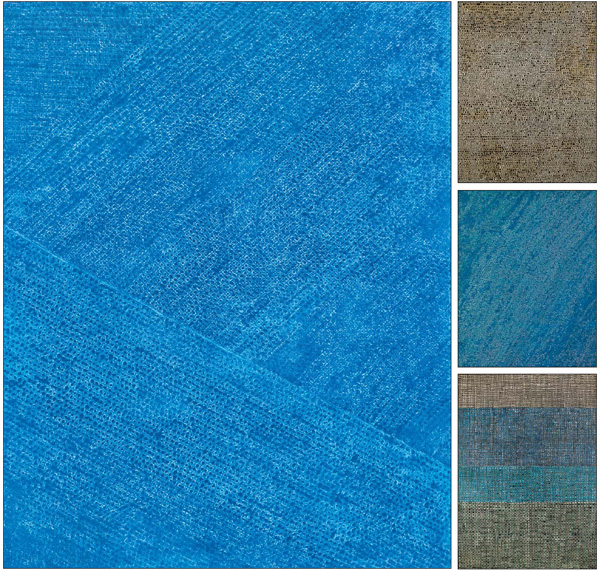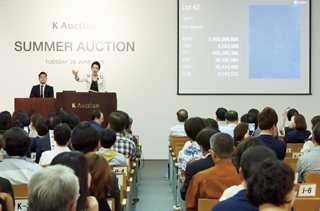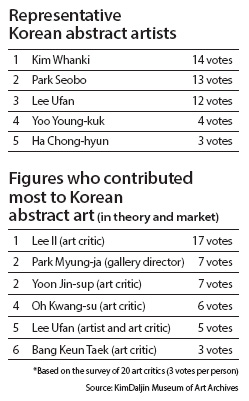Kim Whanki’s art tops sales records

As Kim’s 1972 abstract painting “Untitled 27-VII-72 #228” fetched 5.4 billion won ($4.66 million) at K Auction’s Seoul sale on Tuesday evening, the artist broke not only his own auction price record, but also that of Korean art writ large, for the third time in the past nine months.
“There was tight competition among the bidders who attended the sale in person and those who bid by letter or phone,” said auctioneer Sohn Yee-chun of K Auction.
In October, the Korean abstract art pioneer’s 1971 painting “19-VII-71 #209,” sold for 31 million Hong Kong dollars ($4 million) in a sale by Seoul Auction in Hong Kong, breaking the former record for Korean art set by Park Soo-keun’s painting “Washing Place.”
The record was broken again in April by another one of Kim’s paintings, “Untitled”(1970), which fetched 33 million Hong Kong dollars at another one of Seoul Auction’s Hong Kong sales.
His 1971 painting “Untitled 3-V-71 #203” sold for 30 million Hong Kong dollars in May.
While the former records by Kim’s paintings were set in Hong Kong, the new record was set in Seoul, despite negative factors like the nation’s economic slowdown and the forgery scandal surrounding the work of another important abstract artist, Lee Ufan.
More than anything, the sale indicates Kim’s power in the market at present.
Bolstering the artist’s status, the KimDaljin Art Archives and Museum announced earlier on Tuesday that Kim Whanki topped the list of “Representative Korean Abstract Artists” based on a poll of 20 art critics, historians and curators.
“Kim Whanki has heavy weight not only in art history but also in public recognition,” said Kim Dal-jin, the museum’s head.
Other artists on the list were Park Seobo , Lee Ufan, Yoo Young-kuk and Ha Chong-hyun.
Park, Lee and Ha are associated with Dansaekhwa or Korean monochrome paintings.

Kim’s four record-setting works are all dot paintings from his New York period. The pieces, regarded as his most important, are large-scale, oil-on-cotton paintings that use tens of thousands of round dots surrounded by layers of square borders.
“Kim long had the ambition to fuse East Asian and Western aesthetics and to universally appeal to Eastern and Western people,” Park Mee-jung, head of Whanki Museum, told the Korea JoongAng Daily. “So he converted to pure abstract art in New York and developed dot paintings in the last four or five years of the New York period.”
Before the period, Kim was famous for half-figurative, half-abstract visualizations of Korean and East Asian motifs such as Joseon-era white porcelains, the moon, mountains, clouds and birds using thickly textured oils. He remained faithful to this style even during his time in Paris (1956-59).
But in New York, he dramatically changed “after realizing the importance of new forms and new style for universal appeal,” Park explained.
“The result is Kim’s dot paintings, which are so poetic and lyrical that they even appeal to those who feel unfamiliar with abstract paintings,” Park said. “That’s why dot paintings are so important.”
Now, Kim’s major paintings - including the New-York-period dot paintings - are on display at a large-scale retrospective titled “The Man Is Gone and the Art Has Remained.”

Information about Kim’s life, including photos, his exhibition pamphlets, reviews of his work by critics in newspapers and magazines as well as books about him can be found at the upcoming exhibition “The History of Korean Abstract Art.”
The show, which features 270 documents and photos illuminating the lives of local abstract artists including Kim will start Tuesday at the KimDaljin Art Archives and Museum, which is 20 minute walk from the Whanki Museum.
For those interested in Kim’s process of conception and creation, the “After Drawing” exhibition is a good option. Featuring about 60 drawings by Kim and seven other modern Korean masters, the exhibition runs through July 10 at Gallery Hyundai in the art zone east of Gyeongbok Palace in central Seoul.
BY MOON SO-YOUNG [symoon@joongang.co.kr]










with the Korea JoongAng Daily
To write comments, please log in to one of the accounts.
Standards Board Policy (0/250자)